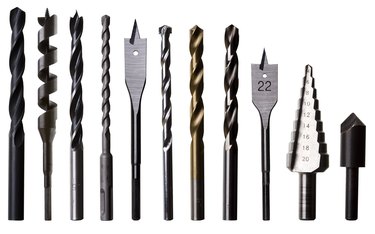Drills prove useful for a variety of household tasks, ranging from easy do-it-yourself projects to complicated construction undertakings. Using a drill properly is key to helping your project go smoothly and for maintaining the longevity of your tools. Drill bits come in a vast array of types, so it's important to know which bit is ideally suited for the task at hand.

Differences in Drill Bits
Drill bits can differ from one another in many respects. One such difference is the length of a drill bit. Generally speaking, the larger the hole you need to drill, the larger your drill bit needs to be. Typically, drill bits come in sets that include a variety of sizes. The size of a bit is measured in inches, and the length is usually represented as a fraction or an integer and a fraction.
Video of the Day
Video of the Day
The shorter your drill bit, the more accurate it is. Choose the smallest bit possible for drilling the hole you need in order to achieve best results.
Drill bits are also made from a variety of materials. Steel or high-speed steel is commonly used for bits. This variety of bit is great for everyday projects and for drilling through soft steel, wood and plastic. Steel bits are typically more affordable than other types, making them a good all-around value.
Cobalt drill bits offer a harder material ideal for drilling into heavier steel or stainless steel items. The downside to cobalt bits is that they tend to cost a bit more than their steel counterparts.
Drill bits can also be made of carbide. This is the hardest and most fragile material used in bit production, and bits made from it should not be used in hand drills. Instead, carbide bits are ideal for professional or heavy production work.
The angle on a drill bit can also vary. Most bits use a 188-degree standard angle, although it is possible to purchase bits with a 135-degree self-centering angle. The latter type is better when it comes to faster initial drill speeds.
The fluting of a drill bit can be either standard, which is usually a 30-degree angle, or parabolic, which is great for soft materials.
Lastly, the coating of a drill bit tip can be made from a variety of materials. Black oxide coatings reduce friction when drilling, as do polished or bright tips. TiN, a gold-colored bit tip coated in titanium nitride, can be used at speeds higher than uncoated drill bits. TiCN, titanium carbonitride, is hard and resists wear better than other bit coatings.
Which Bit is Best for Which Project?
With such a vast array of drill bit characteristics, it can be difficult to select the right one for your project. In general, following certain guidelines will get the job done right.
High-speed steel bits can be used with most DIY projects, but they will last the longest when used only for metalworking. Masonry drill bits, which spiral into a much-harder tip, are great for tasks involving brick or stone. Some drill bits come to a sharp point at the end. Called brad dowell bits, these are excellent for working with wood. Others, with a wide paddle and sharp center, are called wood spade bits and are ideal for drilling very large holes in wooden materials.